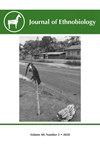关于野生食用菌的本土传统知识:墨西哥中部野生食用菌的文化意义、采摘方法以及导致其丰度变化的因素
IF 1.3
3区 社会学
Q1 ANTHROPOLOGY
引用次数: 0
摘要
野生食用菌(WEM)是全球土著文化的一个重要组成部分;使用野生食用菌是当地社区促进森林保护的森林管理实践的一部分。然而,全球生物文化多样性正受到社会经济、政治和文化变革的威胁。通过参与式研究,本研究分析了选定蘑菇物种的文化意义、当地关于影响 WEM 社区的条件和过程的传统知识,以及墨西哥中部一个土著社区在提取蘑菇时采用的传统做法。我们进行了人种学徒步旅行和参与式测绘,以确定采集地点的特征,并对来自不同社会经济背景的人进行了半结构化访谈,内容涉及 WEM 的重要性、提取和保护的可持续做法,以及影响它们的人为和环境因素。我们登记了 50 种 WEM。我们制定了 WEM 文化重要性指数,从而确定了文化相关性最高的物种。植被类型、降雨量、土壤成分、外来者的选择性砍伐、火灾和传统采摘技术的使用被认为是影响蘑菇产量的因素。当地人认为适当的传统采收技术包括保留部分菌柄、只采集大菇而留下小菇,以及在采集地清洗和摇晃蘑菇。结果表明,有关 WEM 的生物文化知识的普及率受年龄、主要经济活动和家庭与森林的距离的影响。通过结合人种学和定量方法,将传统知识与社区背景相结合,从而为蘑菇采集地的空间、时间和环境特征描述提供了一种互补方法;它还有助于了解影响 WEM 文化意义的因素,以及 WEM 社区及其管理的传统地方知识。本文章由计算机程序翻译,如有差异,请以英文原文为准。
Indigenous Traditional Knowledge on Wild Edible Mushrooms: Cultural Significance, Extraction Practices, and Factors Leading to Changes in Their Abundance in Central Mexico
Wild edible mushrooms (WEM) constitute a relevant component of indigenous cultures worldwide; their use is part of forest management practices that promote conservation by local communities. However, global biocultural diversity is threatened by socioeconomic, political, and cultural changes. Through participatory research, this study analyzes the cultural significance of selected mushroom species, local traditional knowledge about conditions and processes affecting WEM communities, and traditional practices employed in their extraction in an indigenous community in Central Mexico. We carried out ethnomycological hikes and participatory mapping to characterize collection sites and conducted semi-structured interviews with people from diverse socioeconomic backgrounds about the importance of WEM, extraction and conservation sustainable practices, and anthropogenic and environmental factors affecting them. Fifty species of WEM were registered. We developed an index of the cultural importance of WEM that led us to establish the species of the highest cultural relevance. Vegetation type, rainfall, soil composition, selected logging by outsiders, fires, and the use of traditional harvesting techniques were recognized as factors affecting mushroom production. Traditional harvesting techniques locally perceived as adequate include leaving part of the stipe in place, collecting only mushrooms of large size while leaving those of smaller size, and cleaning and shaking them at the place of collection. Results suggest that the prevalence of biocultural knowledge about WEM is influenced by age, main economic activity, and household's distance to the forest. Integrating traditional knowledge and the community context by combining ethnographic and quantitative methods, resulted in a complementary approach to spatial, temporal, and environmental characterization of mushroom collection sites; it also allowed understanding factors influencing WEM cultural significance, and traditional local knowledge of WEM communities and their management.
求助全文
通过发布文献求助,成功后即可免费获取论文全文。
去求助
来源期刊

Journal of Ethnobiology
Social Sciences-Anthropology
CiteScore
4.80
自引率
3.40%
发文量
21
审稿时长
>12 weeks
期刊介绍:
JoE’s readership is as wide and diverse as ethnobiology itself, with readers spanning from both the natural and social sciences. Not surprisingly, a glance at the papers published in the Journal reveals the depth and breadth of topics, extending from studies in archaeology and the origins of agriculture, to folk classification systems, to food composition, plants, birds, mammals, fungi and everything in between.
Research areas published in JoE include but are not limited to neo- and paleo-ethnobiology, zooarchaeology, ethnobotany, ethnozoology, ethnopharmacology, ethnoecology, linguistic ethnobiology, human paleoecology, and many other related fields of study within anthropology and biology, such as taxonomy, conservation biology, ethnography, political ecology, and cognitive and cultural anthropology.
JoE does not limit itself to a single perspective, approach or discipline, but seeks to represent the full spectrum and wide diversity of the field of ethnobiology, including cognitive, symbolic, linguistic, ecological, and economic aspects of human interactions with our living world. Articles that significantly advance ethnobiological theory and/or methodology are particularly welcome, as well as studies bridging across disciplines and knowledge systems. JoE does not publish uncontextualized data such as species lists; appropriate submissions must elaborate on the ethnobiological context of findings.
 求助内容:
求助内容: 应助结果提醒方式:
应助结果提醒方式:


